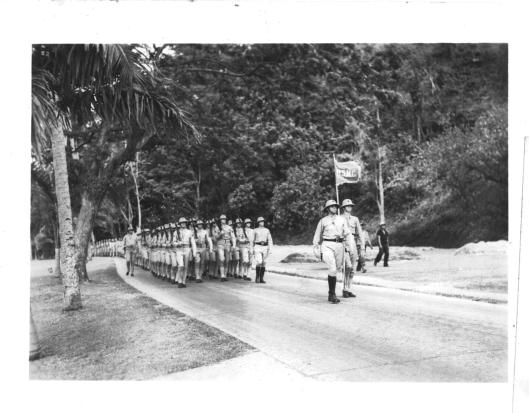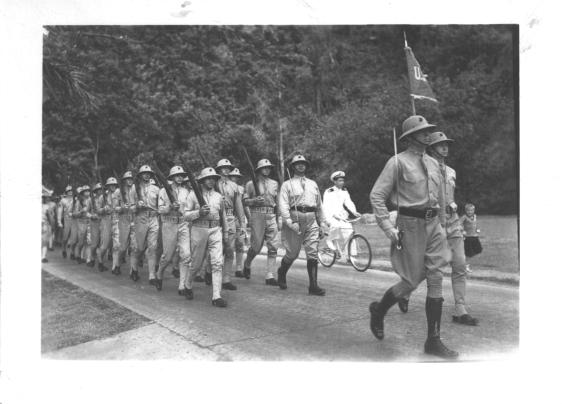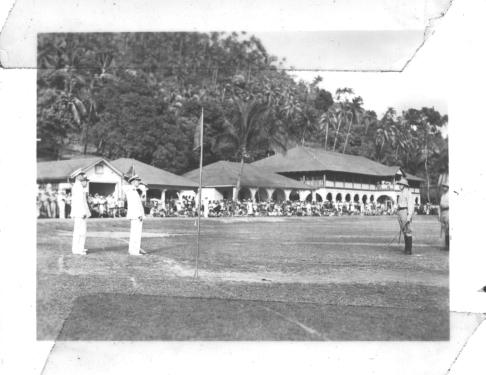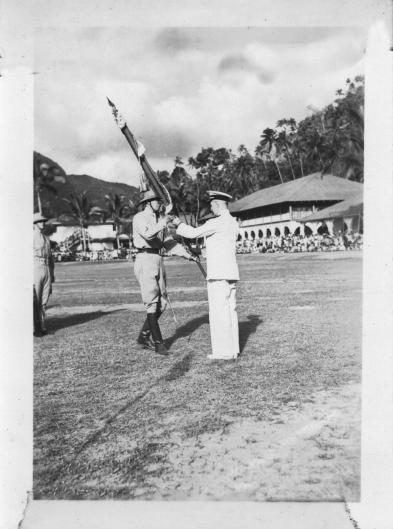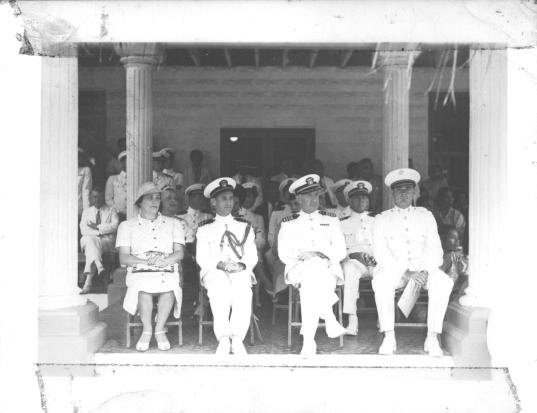|
My Family in American Samoa
on the eve of the Second World War by John Fuhring Page 3 of 7 Please click here to begin at the beginning Build up for the war in the Pacific nobody
(but the War Department) knew was coming It turned out that the decision to go to Samoa was the best possible choice for several reasons. First of all, my parents had a wonderful time on Samoa, it was the happiest time of their lives. They loved the Native Samoans who worked for them and with whom they interacted and they loved the island and it's tropical beauty. Most importantly, although nobody was aware of it at the time, Samoa was not considered important in the Japanese war plans. Unlike Guam, Samoa wasn't attacked, invaded and captured. It is my opinion that I would not be here today if my father would have decided to take the assignment on Guam. I think that it is highly probable that my parents and sisters would have been killed there and I say that because I was stationed on Guam during the late 1960s and had some wonderful talks with older Guamanian natives. They told me of the extreme brutality the Japanese subjected even ordinary natives to. Military personnel and their families, if not killed outright, were treated worse. Before I proceed to show pictures of other things my parents saw on Samoa, I want to tell what I believe is correct regarding why my father was needed on Samoa and then to show pictures of the military buildup that was occurring at the time. In a very real sense, Pearl Harbor can be traced to the secret dealings our own President, Teddy Roosevelt, had in 1905 with what was then a very insular, non-imperial Japan. It was our own Teddy Roosevelt who planted the seed of Empire, urging the Japanese to invade and take Korea and depose its Emperor and who secretly supported the Japanese in the peace negotiations at the end of the Russo-Japanese War when Japan took a large chunk of Manchuria from Imperial Russia. It is my opinion that war with the Empire of Japan was expected by the U.S. War Department from as early as the infamous Paris Peace Conference of 1919, when the Japanese, to everybody's horror, insisted on and got the former German colony of Tsingtao on the Chinese mainland (along with a German brewery that still exports a fine beer under that name). The weak government of China desperately tried to prevent this, but the Japanese had a large fleet, the British needed Japan's help in policing its Asian Empire and so Japan took the colony anyway. This imperial ambition was made even more clear with the first large scale invasion of China in 1931. How ironic that it was a United States president's infatuation with empires and his secret (and probably unconstitutional) dealings that gave birth to the monster that grew into the Japanese Empire. As I've implied, the military planners in the United States were well aware that a Japanese war was coming, so during the 1930s they developed detailed plans and made many very shrewd guesses as to what the Japanese plans were. It so happens that the U.S. planners guessed the details of the Japanese war plans almost perfectly, only they did not know exactly when the Japanese would act. One thing the U.S planners got wrong was how important the Japanese considered Samoa. It was assumed that the Japanese would immediately try to neutralize Samoa's refueling and repair facilities as soon as hostilities began. To counter this assumed threat, U.S. forces and material assets were built up on Samoa. This build-up included the transfer of U.S. Marines from the Mainland, the training of a Native Guard and the build-up of Marine and Naval Shore facilities (including hospital facilities). A Very Low Frequency (VLF) radio station with assured 24/7 world-wide communications and who's signal could be heard by underwater submarines was also built. It so happened that Japan did not consider Samoa very important and so, except for a minor shelling of the Naval Station by one of their submarines, Samoa did not suffer any naval battles or invasions. Of course, nobody knew how little the Japanes valued Samoa, so everybody expected the worst after Pearl Harbor. As an adult, I asked my parents about how people felt regarding the impending war with Japan. I was assured that when war came, it was a complete surprise to them and to most other people too. I think most people were vaguely aware that Japan was playing the part of the villain, but there were no "all news" radio stations and very little discussion of things outside one's circle of friends and family. People were mostly concerned with making a living and raising their families so that international politics and incidents were things too far away and too complex for anybody who wasn't serving in the State Department or the War Department. After the war, by the time I was growing up, things changed drastically, believe me. From the time I can first remember, my father was addicted to "The News" and read and listened to everything that was said regarding the world situation and the prospect for another World War. Of course, the broadcast media had changed drastically and now world news was available all day long on the radio and at regular times on the new media, Television. This addiction to "The News" drove me crazy as a kid and I hated the way my father's head was always buried in a newspaper and how the only radio stations we could listen to while riding in our car were the ones that had "The News" on. Looking back now, being caught unawares and the subsequent trauma of World War Two, left an indelible and painful mark on my father and he was damn sure not going to be caught unawares ever again. And then there is this too: with atomic weapons and a huge arms race going on and with the Republican Party agitating for war "before it's too late to stop the 'Godless Communists', " the prospect of a World War was greater during the decades of the 1950s and 1960s than it was during the long years before December 7th, 1941. After WW II, few people wanted to be ignorant of ongoing world events that had the potential to end civilization in a thermonuclear holocaust. For many reasons, I am convinced that my dad was full of post-traumatic stress arising from his horrific experiences during WW II and, in addition, he was full of anxiety regarding an even worse war involving nuclear weapons. My mother used to tell the story of how, because he was a medical doctor and a Naval officer, my dad was sent to a secret location for special medical training regarding the effects nuclear detonations sometime during the early 1950s. There has always been speculation in my family that he was part of the Enewetak Island experiments and was himself exposed to radiation (he died young of cancer). By all accounts, what he saw and what he learned affected him terribly and thanks to this and what he experienced during WW 2, he was a vastly changed man from his pre-war self. My dad's earlier happiness on Samoa was gone and he was full foreboding. But then, so was I (with our "duck and cover" drills in school and dire news programs on the radio and early TV), so was America (with private back-yard "bomb shelters" and "civil defense" programs), so was the rest of the world. I can remember the very hour of 12:00 PM of January 1, of the year 2000, when I looked back with cynical and wry amusement to when I was in grade school and I remembered that I had been absolutely certain that I would never live to see the new millennium because by the time that this magic date would arrive, the world would be a smoking ruin and we'd all be dead. But then, "better dead than red." Right??? I could say more about this, but again, it is beyond the scope of this story and I have strayed too far from the story. Back to the story.
The next set of photos are of a military ceremony that was part of the pre-war build-up on Samoa. 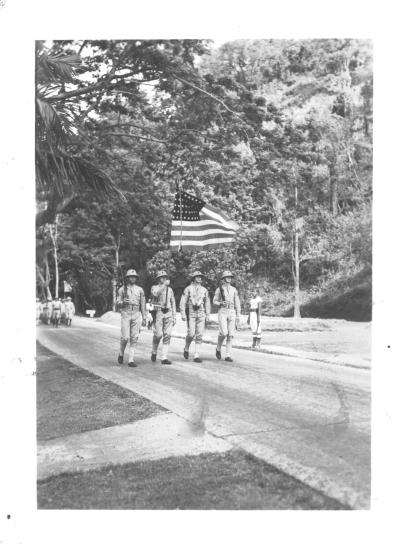
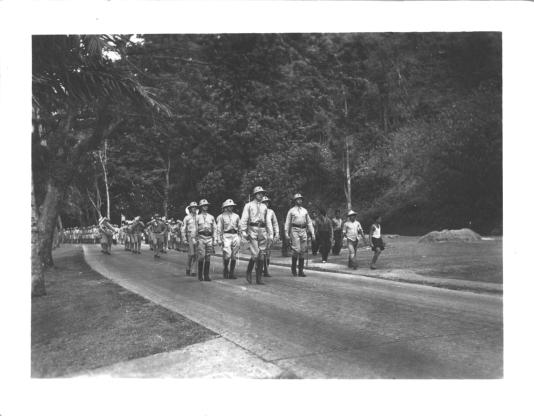 Marine
Officers leading the column with a band following.
High ranking officers and wives.
Note the one Marine officer on the right.
To the left of the Marine is a Naval Captain I assume is the overall Commander of the Naval Forces
of Samoa.
The following are pictures of Samoans who participated in this ceremony: 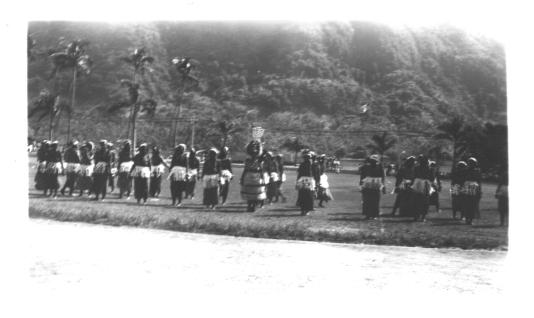 This is a scene that is gone forever. Native Samoans in their traditional dress. 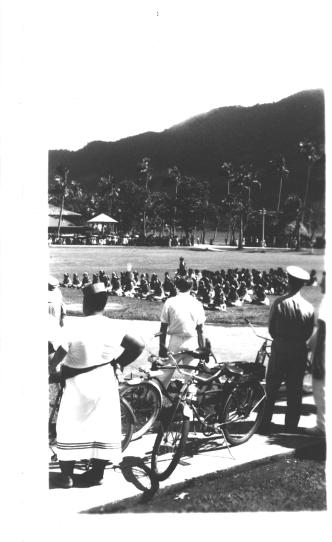 A group of Samoans participating in the military ceremony. Note the Samoan to the far left with the jaunty hat. He is wearing the Samoan Home Guard (Fita Fita) uniform. 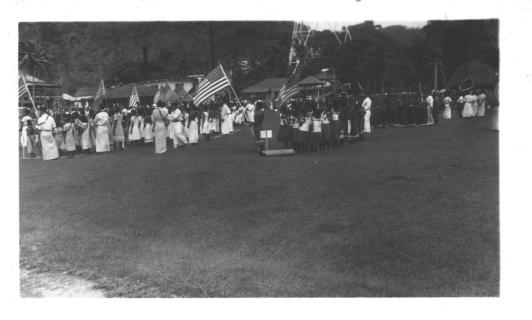 Samoan Home Guard and school
children with American Flags.
Other military related pictures: 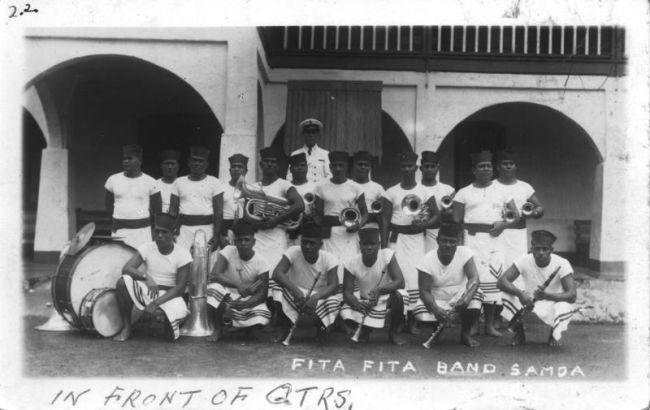 As late as WW II marching bands were an important part of any military. 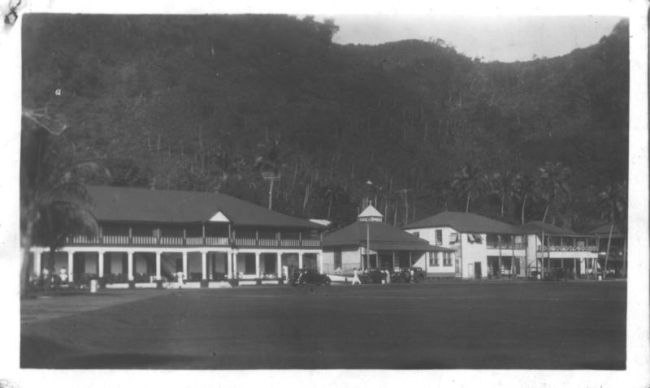 Naval enlisted men's barracks on the left. 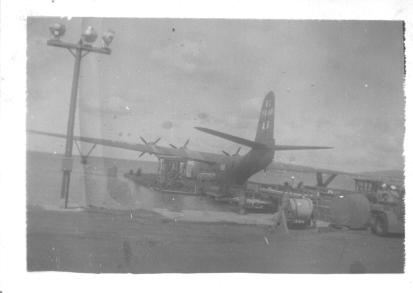 This seaplane has to be one of
the Martin Mars, perhaps the Philippines or Marianas Mars.
These were the largest seaplanes to actually go into service and were originally designed to be bombers until it was realized they flew too low and too slow to be anything but sitting ducks. They made wonderful passenger and cargo planes. One one of them, the Hawaii Mars (which I flew in when I was 3), is still flying to this very day, 65 years after it was built.  A Naval flier (probably a friend
of my dad) next to his two seater seaplane.
These high-wing, open cockpit planes were useful for reconnaissance and needed no runway. 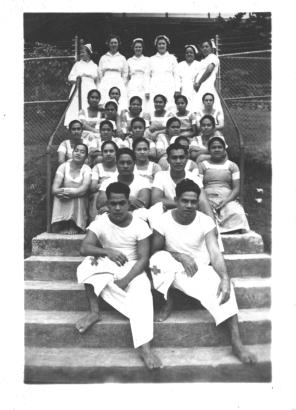 The nurses and Native hospital
staff my father worked with at the Naval Hospital at Pago Pago.
The next page will show and talk about scenes around Samoa as my parents saw them. Please go on to page 4 of
this story
If you entered this story from the outside, Please go to the beginning When you have finished with the last page, I would appreciate reading your comments Please sign my guestbook before leaving For further adventures and
stories, please go to
My Website's Home Page |
